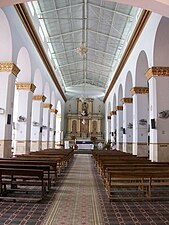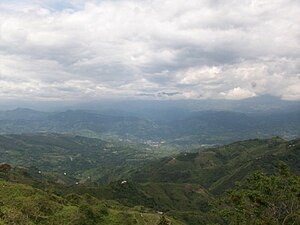Villeta | |
|---|---|
Municipality and town | |
 Bocatoma waterfall in Villeta | |
 Location of Villeta in Cundinamarca | |
| Coordinates: 5°0′29.91″N 74°28′25.61″W / 5.0083083°N 74.4737806°W | |
| Country | |
| Department | |
| Province | Gualivá |
| Founded | 29 September 1551 |
| Founded by | Alonso de Olalla & Hernando de Alcocer |
| Government | |
| • Mayor | Jhon Alexander Morera Gutiérrez (2016-2019) |
| Area | |
• Municipality and town | 140.9 km2 (54.4 sq mi) |
| • Urban | 5.5 km2 (2.1 sq mi) |
| Elevation | 850 m (2,790 ft) |
| Population (2018 census)[1] | |
• Municipality and town | 26,873 |
| • Density | 190/km2 (490/sq mi) |
| • Urban | 17,985 |
| • Urban density | 3,300/km2 (8,500/sq mi) |
| Time zone | UTC-5 (Colombia Standard Time) |
| Website | Official website |
Villeta is a municipality and town in Cundinamarca (Colombia), located in Gualivá Province, approximately 84 kilometres (52 mi) northwest of Bogota, considered the capital of the province. Its name means "Little Village". The municipality borders Quebradanegra and Nimaima in the north, Nocaima and Sasaima in the east, Albán and Vianí in the south and Guaduas in the west. It is situated at an altitude of 850 metres (2,790 ft) in the Eastern Ranges of the Colombian Andes[2]
History
[edit]The region of Villeta before the Spanish conquest was inhabited by the Panche. Modern Villeta was founded as Villa de San Miguel on September 29, 1551, by Alonso de Olalla and Hernando de Alcocer.[3]
Main economic activities in Villeta are related with sugar cane derivatives and as an important tourist center for people from Bogotá due to its warm climate, including ecologic trails, cascades and hotels.
Geology
[edit]The Villeta Group comprising the Conejo, La Frontera, Simijaca, Hiló, Capotes, Socotá, El Peñón and Trincheras Formations is named after Villeta.[4]
Gallery
[edit]-
Old house
-
Church interior
-
Monument to the farmers
-
Landscape of Villeta
References
[edit]- ^ Citypopulation.de Population of Villeta municipality with localities
- ^ Official website Villeta
- ^ History Villeta
- ^ Acosta & Ulloa, 2001, p.39
Bibliography
[edit]- Acosta Garay, Jorge E.; Ulloa Melo, Carlos E. (2002). "Mapa Geológico del Departamento de Cundinamarca - 1:250,000 - Memoria explicativa". INGEOMINAS. pp. 1–108. Retrieved 2017-04-26.
- Acosta Garay, Jorge; Ulloa Melo, Carlos E. (2001). "Geología de la Plancha 208 Villeta - 1:100,000" (PDF). INGEOMINAS. pp. 1–84. Retrieved 2017-06-05.






